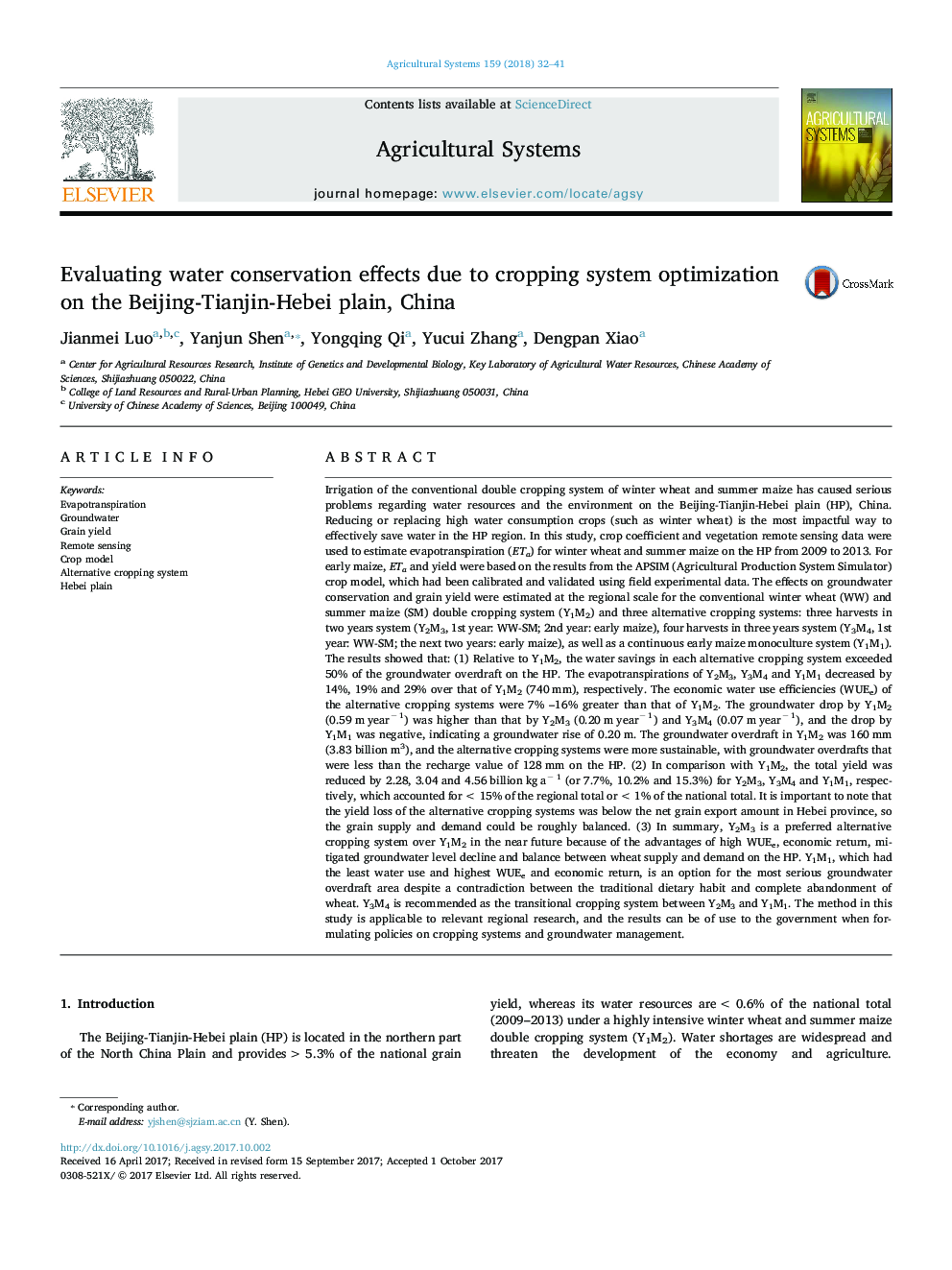| کد مقاله | کد نشریه | سال انتشار | مقاله انگلیسی | نسخه تمام متن |
|---|---|---|---|---|
| 5759599 | 1623211 | 2018 | 10 صفحه PDF | دانلود رایگان |
عنوان انگلیسی مقاله ISI
Evaluating water conservation effects due to cropping system optimization on the Beijing-Tianjin-Hebei plain, China
ترجمه فارسی عنوان
ارزیابی اثرات حفاظت آب به دلیل بهینه سازی سیستم برداشت محصول در دشت پکن-تیانجین-هبی، چین
دانلود مقاله + سفارش ترجمه
دانلود مقاله ISI انگلیسی
رایگان برای ایرانیان
کلمات کلیدی
تبخیر تعرق، آب های زیرزمینی، عملکرد دانه، سنجش از دور، مدل محصول، سیستم برداشت جایگزین، دشت هبی،
موضوعات مرتبط
علوم زیستی و بیوفناوری
علوم کشاورزی و بیولوژیک
علوم کشاورزی و بیولوژیک (عمومی)
چکیده انگلیسی
Irrigation of the conventional double cropping system of winter wheat and summer maize has caused serious problems regarding water resources and the environment on the Beijing-Tianjin-Hebei plain (HP), China. Reducing or replacing high water consumption crops (such as winter wheat) is the most impactful way to effectively save water in the HP region. In this study, crop coefficient and vegetation remote sensing data were used to estimate evapotranspiration (ETa) for winter wheat and summer maize on the HP from 2009 to 2013. For early maize, ETa and yield were based on the results from the APSIM (Agricultural Production System Simulator) crop model, which had been calibrated and validated using field experimental data. The effects on groundwater conservation and grain yield were estimated at the regional scale for the conventional winter wheat (WW) and summer maize (SM) double cropping system (Y1M2) and three alternative cropping systems: three harvests in two years system (Y2M3, 1st year: WW-SM; 2nd year: early maize), four harvests in three years system (Y3M4, 1st year: WW-SM; the next two years: early maize), as well as a continuous early maize monoculture system (Y1M1). The results showed that: (1) Relative to Y1M2, the water savings in each alternative cropping system exceeded 50% of the groundwater overdraft on the HP. The evapotranspirations of Y2M3, Y3M4 and Y1M1 decreased by 14%, 19% and 29% over that of Y1M2 (740 mm), respectively. The economic water use efficiencies (WUEe) of the alternative cropping systems were 7% -16% greater than that of Y1M2. The groundwater drop by Y1M2 (0.59 m yearâ 1) was higher than that by Y2M3 (0.20 m yearâ 1) and Y3M4 (0.07 m yearâ 1), and the drop by Y1M1 was negative, indicating a groundwater rise of 0.20 m. The groundwater overdraft in Y1M2 was 160 mm (3.83 billion m3), and the alternative cropping systems were more sustainable, with groundwater overdrafts that were less than the recharge value of 128 mm on the HP. (2) In comparison with Y1M2, the total yield was reduced by 2.28, 3.04 and 4.56 billion kg aâ 1 (or 7.7%, 10.2% and 15.3%) for Y2M3, Y3M4 and Y1M1, respectively, which accounted for < 15% of the regional total or < 1% of the national total. It is important to note that the yield loss of the alternative cropping systems was below the net grain export amount in Hebei province, so the grain supply and demand could be roughly balanced. (3) In summary, Y2M3 is a preferred alternative cropping system over Y1M2 in the near future because of the advantages of high WUEe, economic return, mitigated groundwater level decline and balance between wheat supply and demand on the HP. Y1M1, which had the least water use and highest WUEe and economic return, is an option for the most serious groundwater overdraft area despite a contradiction between the traditional dietary habit and complete abandonment of wheat. Y3M4 is recommended as the transitional cropping system between Y2M3 and Y1M1. The method in this study is applicable to relevant regional research, and the results can be of use to the government when formulating policies on cropping systems and groundwater management.
ناشر
Database: Elsevier - ScienceDirect (ساینس دایرکت)
Journal: Agricultural Systems - Volume 159, January 2018, Pages 32-41
Journal: Agricultural Systems - Volume 159, January 2018, Pages 32-41
نویسندگان
Jianmei Luo, Yanjun Shen, Yongqing Qi, Yucui Zhang, Dengpan Xiao,
